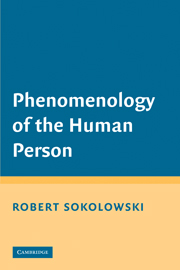Book contents
- Frontmatter
- Contents
- Acknowledgments
- Phenomenology of the Human Person
- Introduction
- PART I THE FORM OF THINKING
- 1 Two Ways of Saying “I”
- 2 Further Kinds of Declaratives
- 3 Linguistic Syntax and Human Reason
- 4 The Person as the Agent of Syntax
- 5 Reason as Public
- 6 Grammatical Signals and Veracity
- PART II THE CONTENT OF THINKING
- PART III THE BODY AND HUMAN ACTION
- PART IV ANCIENTS AND MODERNS
- 19 Conclusion, with Henry James
- Bibliography
- Index
6 - Grammatical Signals and Veracity
Published online by Cambridge University Press: 05 June 2012
- Frontmatter
- Contents
- Acknowledgments
- Phenomenology of the Human Person
- Introduction
- PART I THE FORM OF THINKING
- 1 Two Ways of Saying “I”
- 2 Further Kinds of Declaratives
- 3 Linguistic Syntax and Human Reason
- 4 The Person as the Agent of Syntax
- 5 Reason as Public
- 6 Grammatical Signals and Veracity
- PART II THE CONTENT OF THINKING
- PART III THE BODY AND HUMAN ACTION
- PART IV ANCIENTS AND MODERNS
- 19 Conclusion, with Henry James
- Bibliography
- Index
Summary
We have shown how human rationality is exhibited in the syntactic compositions that human beings introduce into their discourse. Such syntax occurs most palpably in the strings of words that are spoken or written. When it occurs in speech, in the use of language, it is called grammar. But syntax is also present in the meanings or concepts or propositions that are woven into the words, and there it can be called logical grammar or logical syntax. Finally, syntax also occurs in the things that are being presented: if I articulate a tree as blossoming, I distinguish between the tree and its blossoming, the thing and its feature, and I compose them into a formulated whole. The tree is presented or manifested in its whole and parts. Here we might speak of ontological syntax or perhaps of the formal relations between a thing and its various attributes. I have already said that the most troublesome of these three fields for syntax is that of meanings, concepts, or propositions, and I now repeat my promise to explain later on what that domain is.
What I wish to examine in this chapter is the special way in which the grammar of speech is related to the cognitive activities of the speaker and listener. In earlier chapters we discussed the various parts of speech and showed how grammar allows us to embed some phrases within others and to organize them hierarchically.
- Type
- Chapter
- Information
- Phenomenology of the Human Person , pp. 80 - 96Publisher: Cambridge University PressPrint publication year: 2008

